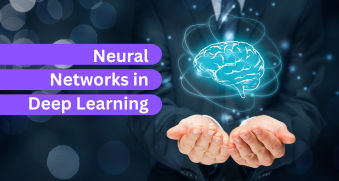Neural Networks in Deep Learning
Driving applications in image identification, natural language processing, and robotics, neural networks and deep learning have transformed the discipline of artificial intelligence.


Introduction
Driving applications in image identification, natural language processing, and robotics, neural networks and deep learning have transformed the discipline of artificial intelligence. We will investigate deep learning neural networks in this blog including its architecture, training method, kinds, and practical uses.
Understanding Neural Networks
A neural network is a computational model inspired by the human brain, consisting of layers of neurons that process information. It learns patterns from data through a process called training.
Components of a Neural Network:
- Neural networks consist of multiple components that work together to process data, learn patterns, and make deep learning and machine learning predictions.
- Neurons (Nodes): Fundamental units that receive input, apply a function, and produce output.
- Weights and Biases: Adjustable parameters that determine the importance of inputs.
- Activation Functions: Functions that introduce non-linearity, allowing networks to learn complex patterns.
- Layers:
1. Input Layer: Receives raw data.
2. Hidden Layers: Perform computations and feature extraction.
3. Output Layer: Produces final predictions.
Types of Neural Networks
- Input Layer – Takes in the data.
- Hidden Layers – Process the data using mathematical operations.
- Output Layer – Gives the final result
Convolutional Neural Network (CNN)
Mostly used for image processing and computer vision applications, a Convolutional Neural Network (CNN) is a particular kind of deep learning neural network. In artificial intelligence, computer vision is the study and understanding of pictures or visual data for computers.
- Designed for sequential data like time series and text.
- Uses loops to retain past information.
- Applications: Language translation, speech recognition, and stock price prediction.
Long Short-Term Memory (LSTM)
Long Short-Term Memory (LSTM) is a special type of Recurrent Neural Network (RNN) that is great at handling long-term dependencies in data. It is mainly used for sequence prediction tasks, where the order of information matters.
LSTMs are ideal for tasks like:
- Time-series forecasting (e.g., predicting stock prices)
- Machine translation (e.g., converting English to French)
- Speech recognition (e.g., voice assistants like Siri)
- A type of RNN with memory cells to store long-term dependencies.
- Applications: Sentiment analysis, handwriting recognition, and chatbot responses.
Generative Adversarial Networks (GANs)
- Consist of a generator and a discriminator in a competitive setup.
- Used for data generation, deepfake creation, and artistic content synthesis.
Transformer Networks
- Use self-attention mechanisms.
- Power modern NLP models like BERT and GPT.
- Applications: Chatbots, text summarization, and machine translation.


CATEGORIES
- MBA Program
- Data Science and Analytics
- Cloud Computing
- Data Analytics and Business Intelligence
- AI and Digital Systems
- Cyber Security and Digital Forensics
- Business Analytics & Intelligence
- Banking & Financial Services
- International Business
- Digital Marketing
- Research Paper
- Media & Entertainment
- Media Management
- Journalism and Media Production
- Media & Information Technology
- Visual Communication
- Game Development
- Sound Engineering
- Game Art & Design
- Photography
- Film Making
- Animation & VFX
Are you aspiring to become a proficient AI and Digital Systems professional?
Look no further; we are committed to nurturing the potential of young minds. Are you ready to enhance your skills?


